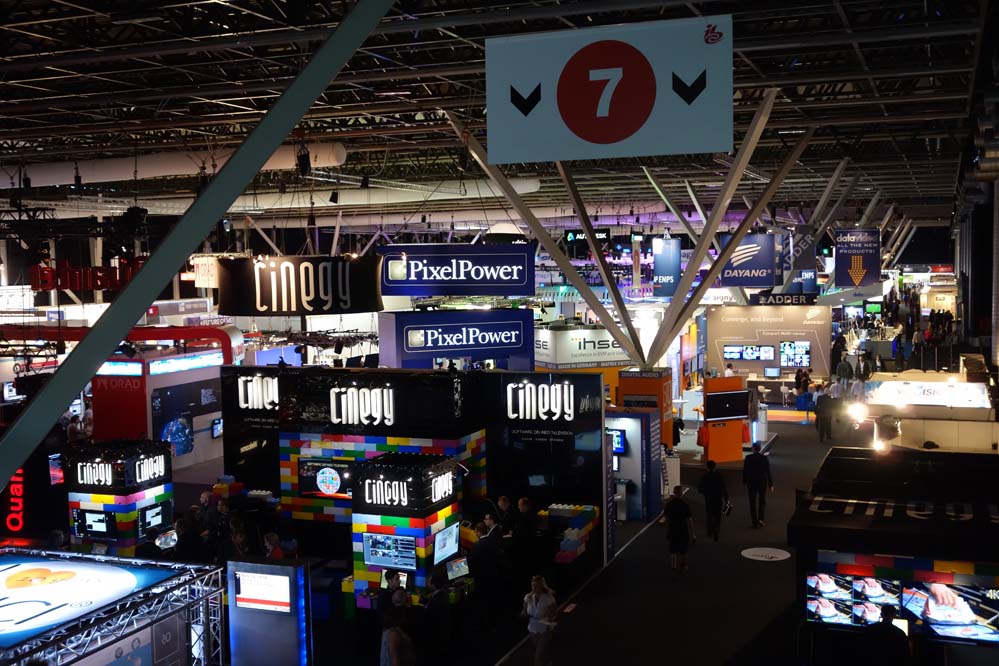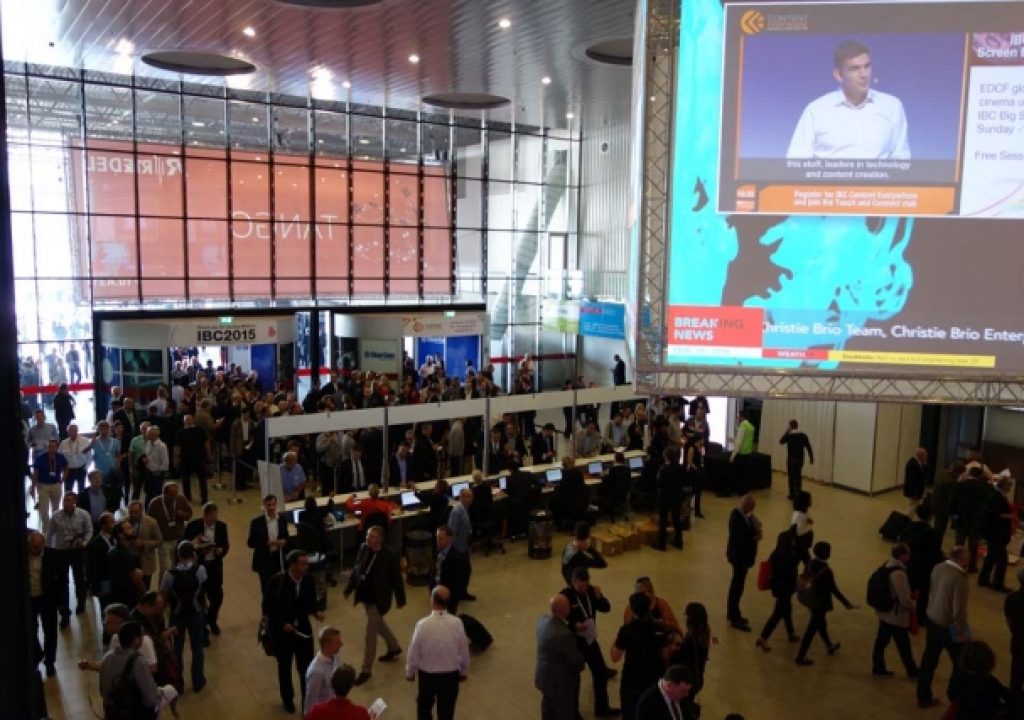
The first day of a trade show is typically a little bit crazy. Attendees try to cover as much ground as they can to get a sense of the event, while exhibitors are focused on talking to as many people as they can while also trying to find time to prepare for or attend a session.
At least, that’s what my experience has been, but true to form, IBC unfolded in a much different way. Rather than the frenzied panic that dominates most shows before they kick off, IBC 2014 featured a very relaxed atmosphere that permeated the show floor. Several exhibitors have mentioned that Saturday and Sunday are usually the busiest days of the show, so that relaxed and calm atmosphere might not last long.
Regardless, it was a productive first offical day after our conference preview. We bounced between various halls in the massive Amsterdam RAI and got some detailed info about various brand new products and announcements. And this is just a portion of what we're set to cover as IBC continues throughout the weekend.
Cameras and Lenses
Among several big announcements, AJA revealed that the AJA Raw CION camera format will soon be supported in Adobe Premiere Pro CC. They also announced the release of the v1.1 update FS1-X, the 1RU frame synchronizer and converter with a broad range of features for integrating video and audio in broadcast, mobile and post-production environments. But it was the CION that once again was the highlight for AJA, and that went beyond the news about announcing support from Alphatron, MTF, Wooden Camera, Vocas and Zacuto for the Cion.
Many people were waiting to hear news about a shipping date for the camera, but the closest we got to finding out when we’d be able to get our hands on it was “soon”. That is undoubtedly disappointing to some, but it’s encouraging to see AJA not simply interested in pushing the camera out the door and instead making a conscious attempt to get this right.
“We're focued on the final fineness,” explained Andy Bellamy, Field Sales Engineer for AJA. “There’s a huge difference between almost ready and ready, and we’re just not quite there yet. We know we can make it better, and we will.”
We did get to see some amazing footage from the camera though, which AJA made active just today. It showcases completely raw and ungraded test footage, and the folks at the booth were very proud of how it turned out. Take a look for yourself…
CION – Science of the Beautiful; Ungraded Images Reel from AJA Marketing on Vimeo.
Speaking of cameras, we also made our way over to the Blackmagic booth where the big news was around the new PL mounts. The Blackmagic Production Camera 4K PL and Blackmagic Cinema Camera PL now include PL mount models, for using professional cinema lenses or even vintage cinema lenses. This means cinematographers now have a professional PL mount digital film camera that’s so small, the camera body is only a little larger than the lens mount itself.
“People have been asking about PL mounts for these cameras for awhile now,” said Kendall Eckman, Regional Manager at Blackmagic Design. “This is proof that not only do we listen to customer feedback, but we rely on it.”
Details around the 1.9.5 firmware update were a big topic of our discussion as well, as the firmware update included in-camera formatting of SSD cards and audio meters. As usual, their booth was one of the most popular, although it’s kind of odd to see them grouped with traditional software and post-production companies now that they’re showcasing cameras.
Since we’re talking about cameras, it probably makes sense to shift over to lenses, and Zeiss was showing off prototypes that they are currently testing and refining. At IBC, attendees could check out prototypes of a servo unit for the high-end Zeiss Compact Zoom CZ.2 cine lenses. The new ZEISS Servo Unit can be controlled directly on the handgrip, through broadcast demands, or via wireless lens control systems, as is often the case for cranes.
“What we’re showing at IBC is just a prototype,” said Tobias Brandstetter, PR manager for Zeiss. “When it's ready, it’s going to be a very future proof solution.”
Cooke Optics had a number of their products on hand for attendees to check out, as the company manufactures a wide range of lenses suitable for multiple film applications. A focus on anthropomorphic lenses has dominated their focus lately though. Lenses available include : 25, 32, 40, 50, 75, 100 and 135mm with 2x squeeze and also feature a T2.3 aperture
“Digital is boring as acquisition,” said Les Zellan of Cooke Optics. “Choices with film are not present in digital, and the reemergence of anthropomorphic has to do with the digital format. You can talk about 2K, 4K, 8K or however many K you want, but you can’t get the look you need with the stock, you get what you need with the lens.”
Cooke S4, 5/I and Minis are all still shipping, and they also have a new metadata system coming out soon.
Updates Galore
Adobe had a large booth right in the center of Hall 7 and that made it easy for attendees to spot them for the numerous presentations they had lined up throughout the day. Philip Bloom, Bryn Balcombe and Andreas Gall were just a few of the people who took the stage on Friday, but the updates to CC were big topics of discussion as well.
In Adobe Premiere Pro CC, users can now automatically generate new bins based on search criteria, including Advanced Timeline Search. Search bins will also update automatically as you add new content to your projects.
“It’s really a great way to find what you need,” said Niels Stevens, Business Development manager for Adobe. “As projects get bigger and bigger, it’s that much more important to have that ability so you’re not burning a ton of time just trying to find what you need.”
Adobe also announced updates to After Effects, as the next release of After Effects offers an enhanced Live 3D Pipeline, allowing artists to work faster with 3D elements in the compositions, enhanced Anywhere collaboration, and usability refinements that make motion graphics and visual effects work easier and more efficient.
For more about the Adobe CC updates, check out what Rich Young put together.
Autodesk acquired Shotgun back in June, but developments around that transaction continue to be rolled out. Shotgun launched an iPhone Review App, Shotgun Desktop, and MARI Integration at SIGGRAPH 2014 but at IBC the focus was around how people are using their products.
“One of the things that’s become clear to us is that production management is becoming much more essential to the tools people use,” said Maurice Patel, Entertainment Industry Manager for Autodesk. “People want flexibility in how they consume their software. Some users might only want to have access to a particular software or license for a single project, and that’s the kind of flexibility we have and continue to make available to them”
Shotgun, Flame and their desktop subscriptions were the big focus for Autodesk at IBC, as they unveiled Flame 2015 visual effects software Extension 2, with included support for Shotgun Software, a cloud-based production tracking, review and asset management platform. A few of those highlights include automated access to media and batch setups in Flare and shot versioning. Check out more from them at IBC on their AREA blog.
Storage and Such
Storage capacity continues to grow in leaps and bounds, and nowhere is that more evident than at the SanDisk booth. At IBC, they showed off their 512 gigabyte SD card, which completes a 1,000x increase in storage space on SD cards in just over 10 years.
“We literally have rocket scientists working on our products,” said Brian Pridgeon, Product Marketing Manager at SanDisk. “SD has really become applicable for pros, and it’s why we’re thrilled to have options for the people using something as complex as an ALEXA to as simple as a GoPro.”
Sticking with storage, G-Tech has just announced quite an update. Expanding on their Studio Line, which launched earlier this year, they have announced the G-SPEED Studio XL. The unit holds up to eight removable enterprise-class 7,200 RPM hard drives, offering colossal capacity and performance of up to 1,350 megabytes per second performance for the most demanding digital content creation applications.
“Needs have evolved and people are looking for storage solutions that aren’t going to tie them to a particular location or system,” said Greg Crosby, Product Line Manager at G-Tech. “The video on display at the booth here shows how someone who has a bulky and cumbersome storage unit can easily downsize without losing any storage space and also freeing themselves from that unmovable unit.”
The G-SPEED Studio XL eight-bay Thunderbolt 2 storage solution comes in a high-quality, black enclosure with integrated cooling technology. It also supports 4k workflows with user-configurable RAID 0, 1, 5, 10, 50 and 60, and transfer rates of up to 1,350MB/sec in RAID 0.
Improve Your Workflow and Production
Matrox had a number of announcements for IBC, including that Mojito 4K will support the next release of Adobe Creative Cloud, their collaboration with Kontron to deliver cloud computing platforms to OEMs of high density video acquisition and transcoding systems as well as the world’s first SDI cards with 12 Reconfigurable inputs/outputs, which we wanted to discuss further.
“Higher density is always useful for OEM’s because it gives you more options,” said Donald Sievewright, Sales Director at Matrox. “If you can get more functionality from a single board you’re saving space and making yourself more efficient, which is a win-win.”
From their press release…
The half-length PCIe cards offers up to 12 reconfigurable I/Os, from SD to 4K, along with support for AES/EBU, LTC and GPIO. All inputs have built-in frame synchronizers to generate clean SDI signals for any environment. On Matrox X.mio3 FH, multi-channel hardware processing accelerates compute-intensive operations including motion-adaptive de-interlacing, up/down/cross scaling and mixing/compositing for all resolutions.
At the NVIDIA booth, their Visual Computing Appliance (VCA) was the focus. The unit harnesses the power of the highest-performing NVIDIA GPUs and is accessible to anyone on the network while being able to be easily integrated into design workflows. It also effortlessly scales to multiple VCAs.
“Data sets are getting bigger and bigger,” said Andrew Page from NVIDIA. “We hear that people want to work from anywhere, but if they don’t have access to the network how can they use GPU to accelerate rendering?”
Being able to allow users to take advantage of a system regardless of their location has clearly been a focus for NVIDIA, as they've worked to give everyone from editors to animators to graphic designers GPU power to help them efficiently complete their work.
NewTek had some big news with the announcement of TalkShow, a video calling production system. With TalkShow, any television or live video producer can easily reach anyone who uses Skype and incorporate them as guests speakers into live programs.
“If you’re the host, you don’t need to be the operator,” said Ellen Camloh from NewTek. “The host doesn’t need to worry about the technology and neither does the person who is using Skype to join the program or call. To them it’s the same experience, but TalkShow makes everything look and feel much improved for the audience.”
Although it’s not a requirement, producers using TalkShow with a TriCaster will be able to route Skype video calls directly to and from a TriCaster over a network connection without tying up an additional HD-SDI input. So you don't have to use a TriCaster with the unit but doing so will definitely be an improved experience.
Click to Page 2 to see more images from IBC.

